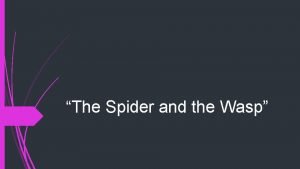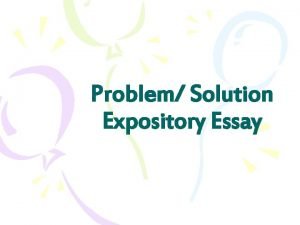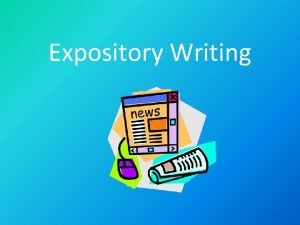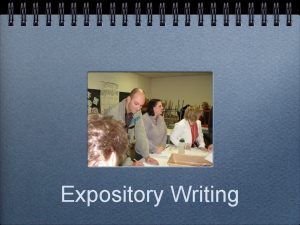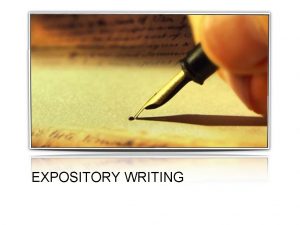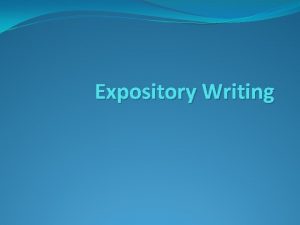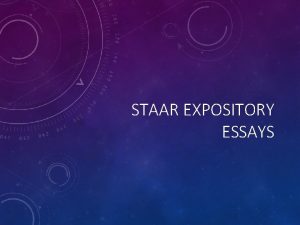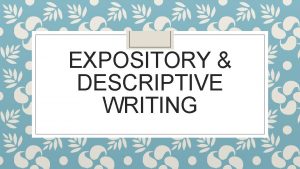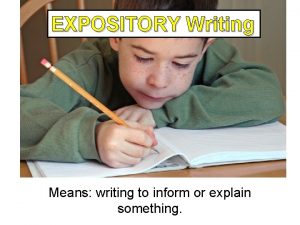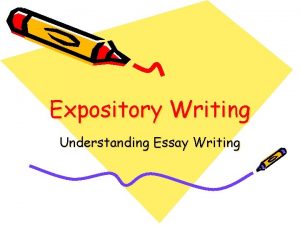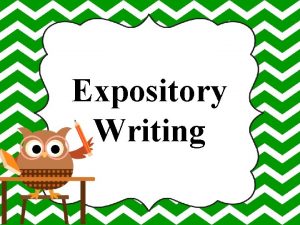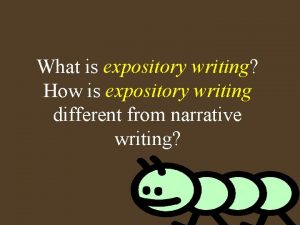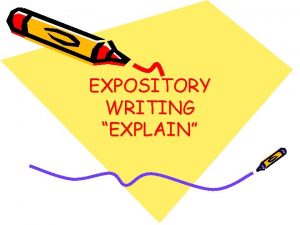Expository Writing The How and Why of Writing















- Slides: 15

Expository Writing The “How and Why” of Writing

What is Expository Writing? • Expository writing is defined as presenting reasons, explanations, or steps in a process • Informational writing • An expository essay should follow a logical sequence and have three different main points • Logic and coherence is the main focus of an expository essay

Expository writing needs: • • • One topic Reasons supporting that topic Details supporting the reasons A conclusion re-stating the reasons Transition words Clear, concise, logical and informative language

Outline for Expository Title: I. Introduction: • • Hook Thesis Statement Reasons that support topic (3) Background information on topic (3 reasons/sentences) Body Paragraphs II. First Reason (Paragraph 1) - III. Second Reason (Paragraph 2) - IV. Third Reason (Paragraph 3) 1. Fact/ or example explaining reason 2. Detail supporting fact/example Sum- up statement V. Conclusion: Re- state all reasons in conclusion Clincher sentence- gives a summation of the above and a “feeling” about the whole essay. Use transition words, plan reasons in a logical order, make sure you re-state reasons in your conclusion.

Expository Writing – P. 1 Introduction: main idea and what the essay is about • The 3 main reasons supporting this main idea – P. 2: 1 st reason & give details to support the 1 st reason – P. 3: 2 nd reason & give details to support the 2 nd reason – P. 4: 3 rd reason & give details to support the 3 rd reason – P. 5 Conclusion: re-state all the reasons

Definition of Terms • Thesis Statement: The main idea of the whole essay • Transition words: Words such as first, second, as a result, which make transitions easy in the essay. • Main Ideas: Each paragraph should have a main point or idea • Supporting Details: Details support the main ideas

Introduction Hook Catch your readers attention with a question, quote, short anecdote, or personal experience statement. Thesis Statement Can be what you believe and what you explain or prove. It is in the intro. /con. and is implied throughout any of the paragraphs.

Support 1 st Idea nd 2 Idea rd 3 Idea Write one informational sentence about each idea you are going to write about

Details • • Can be descriptive Can be factual Can be from personal experience Can be anecdotes (a short and interesting story, or an amusing event, often proposed to support or demonstrate some point, and to make the audience laugh)

Body Paragraph’s • State the main idea for each paragraph (reasons) • 3 supporting details that support main idea that include (3 sentences): – details, personal experiences, facts, anecdotes.

Conclusion • Re-state all of your reasons in your conclusion 1. Reason 2. Reason 3. Reason • Re-state thesis statement (proving statement)

Transition words • Add your transition words – First – Second – Third – Finally, or In Conclusion

Editing your essay • Check all the elements of an expository essay: – Reasons – Details – Transition words – Conclusion that re-states your topic – Grammar – Coherence, logic and clearly written

Expository Essay: There are three different types of expository essays: 1) Essay that is developed with examples and/or facts and statistics 2) Essay that is developed with steps in a process 3) Essay that is in a compare and contrast format Introductory Paragraph: A. Thesis sentence B. Background info C. Statistics- if relevant Body Paragraphs: Paragraph 2: Reason#1 or Process #1 Use a transition word A. Example/detail #1 B. Example/detail #2 C. Example/detail#3 Paragraph 3: Reason #2 or Process #2 Use a transition word A. Example/detail #1 B. Example/detail#2 C. Example/detail #3 Paragraph 4: Reason #3 or Process #3 Use a transition word A. Example/detail #1 B. Example/detail #2 C. Example/detail#3 Conclusion Paragraph: Take a reason from each paragraph and RE-STATE it in the conclusion. Add a clincher sentence. Evaluation: Do you have a clear logical topic? Have you introduced your topic in the first paragraph? Do you have one reason per paragraph? Do you have three details to support each reason? Have you used transition words at the beginning of each paragraph?

How is it different ? • Expository writing does not tell a story • Expository writing does not persuade a reader but only gives facts and reasons • Expository writing can also give the steps of a process
 Hey hey bye bye
Hey hey bye bye Structure of expository writing
Structure of expository writing Dont ask
Dont ask What is the main idea of the spider and the wasp
What is the main idea of the spider and the wasp Problem and solution expository essay
Problem and solution expository essay Argumentative vs expository
Argumentative vs expository Hát kết hợp bộ gõ cơ thể
Hát kết hợp bộ gõ cơ thể Frameset trong html5
Frameset trong html5 Bổ thể
Bổ thể Tỉ lệ cơ thể trẻ em
Tỉ lệ cơ thể trẻ em Chó sói
Chó sói Tư thế worm breton
Tư thế worm breton Chúa yêu trần thế
Chúa yêu trần thế Các môn thể thao bắt đầu bằng tiếng bóng
Các môn thể thao bắt đầu bằng tiếng bóng Thế nào là hệ số cao nhất
Thế nào là hệ số cao nhất Các châu lục và đại dương trên thế giới
Các châu lục và đại dương trên thế giới



